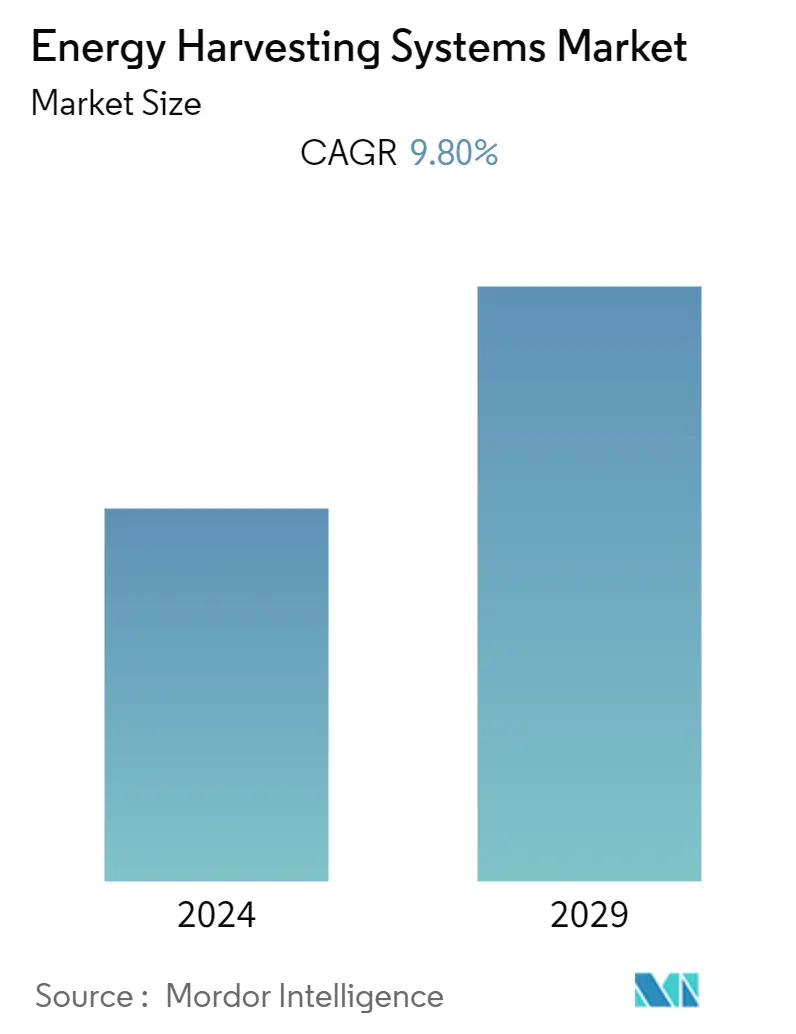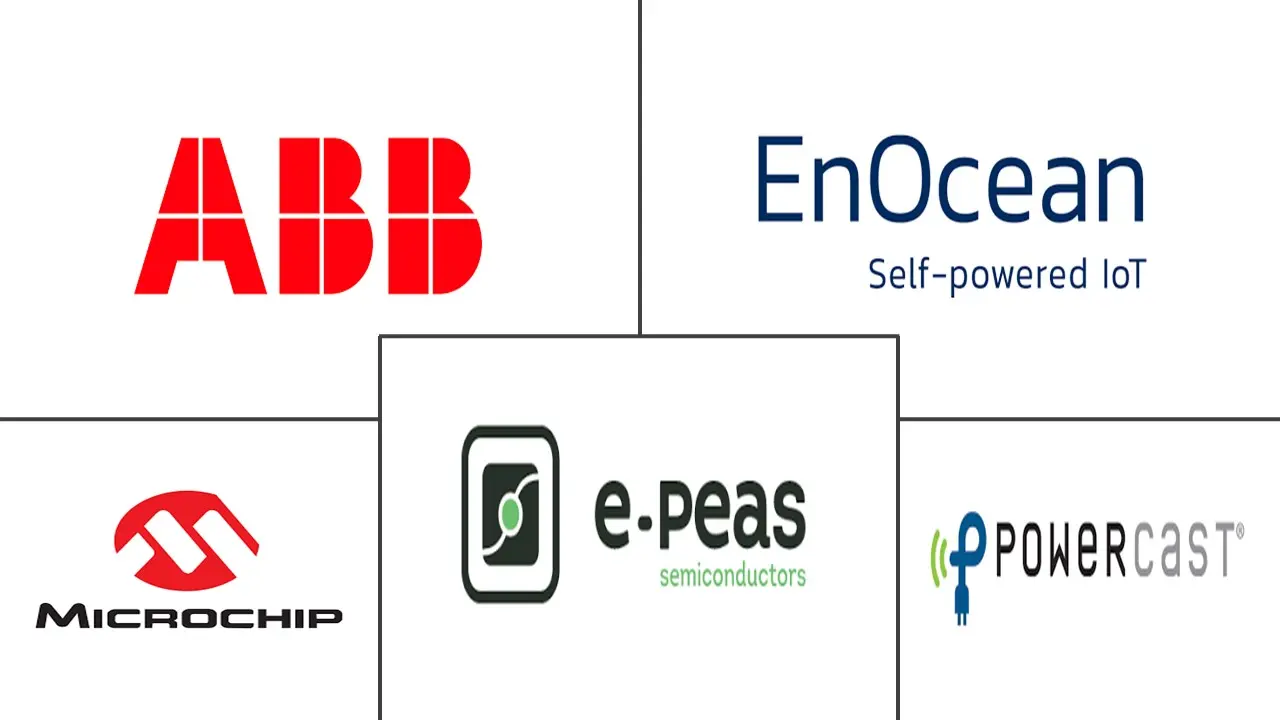Market Size of Energy Harvesting Systems Industry

| Study Period | 2019 - 2029 |
| Base Year For Estimation | 2023 |
| CAGR | 9.80 % |
| Fastest Growing Market | Asia Pacific |
| Largest Market | North America |
| Market Concentration | Low |
Major Players
*Disclaimer: Major Players sorted in no particular order |
Energy Harvesting Systems Market Analysis
The Global Energy Harvesting Systems Market will register a CAGR of 9.8% over the forecast period. Energy harvesting, also known as power harvesting or energy scavenging, is the process by which energy is derived from external sources. Ambient energy, the energy source for energy harvesting systems, is present as ambient background and is freely available.
- The widespread use of IoT devices in automation, the expansion of urban areas, the rising demand for reliable, safe, and long-lasting systems, the increasing popularity of green energy, the widespread adoption of energy harvesting technology in building and home automation, and supportive government policies are all anticipated to contribute to the market's expansion during the forecast period.
- Energy harvesting systems are primarily used in low-power electrical utilities, such as sensors, watches, and home appliances. These systems provide an efficient alternative to conventional power sources, like batteries.
- Moreover, supportive government policies and increased awareness about the environment, along with the reduction in the emission of greenhouse gases, have helped raise the demand for such technologies.
- Using energy harvesting systems is advantageous since the connected devices can run for a very long time without causing adverse environmental effects. Additionally, the solar, thermal, and vibrational energy forms of energy are those that energy harvesting systems use the most frequently among the various sources of ambient energy, including light energy, thermal energy, radiofrequency energy, kinetic energy, chemical/biological energy, and others.
- The energy harvesting systems are also deployed in applications that require a backup battery, and primarily battery is located remotely at a difficult place to reach. The transmitters and receivers used in the energy harvesting systems should be installed close to each other for better signal transmission. Collecting data at the central receiver is difficult when these sensors are deployed in remote locations.
- Owing to the outbreak of the COVID-19 pandemic, the Chinese solar industry and its economy are reeling under the impact. The exports are yet to be gauged fully. Such delay would restrict the growth of the energy harvesting systems.
Energy Harvesting Systems Industry Segmentation
Energy harvesting, also known as power harvesting or energy scavenging, is the process by which energy is derived from external sources. Ambient energy, the energy source for energy harvesting systems, is present as ambient background and is freely available.
The Global Energy Harvesting Systems Market is segmented by Technology (Light Energy Harvesting, Vibration Energy Harvesting, Thermal Energy Harvesting, and RF Energy Harvesting), Application (Consumer Electronics, Building, and Home Automation, Industrial, Transportation), and Geography.
The market sizes and forecasts are provided in terms of value (USD million) for all the above segments.
| By Technology | |
| Light Energy Harvesting | |
| Vibration Energy Harvesting | |
| Thermal Energy Harvesting | |
| RF Energy Harvesting |
| By Application | |
| Consumer Electronics | |
| Building and Home Automation | |
| Industrial | |
| Transportation | |
| Other Applications |
| By Geography | |
| North America | |
| Europe | |
| Asia Pacific | |
| Rest of the World |
Energy Harvesting Systems Market Size Summary
The energy harvesting systems market is poised for significant growth, driven by the increasing integration of IoT devices in automation and the expanding urban landscape. These systems, which capture ambient energy from sources like solar, thermal, and vibrational energy, offer a sustainable alternative to traditional power sources such as batteries. The rising demand for reliable and long-lasting systems, coupled with the growing popularity of green energy, is further propelling the market. Energy harvesting technology is being widely adopted in building and home automation, supported by favorable government policies and heightened environmental awareness. This technology is particularly beneficial in low-power applications, including sensors, wearables, and remote control units, where it extends the operational life of devices without adverse environmental impacts.
North America stands out as a key region for energy harvesting systems, driven by rapid technological advancements and a strong focus on renewable energy in building and home automation. The United States, in particular, is witnessing significant growth due to its industrial and transportation sectors and government initiatives aimed at energy independence. The market is highly competitive, with major players like ABB Limited and STMicroelectronics NV leading the charge, while new entrants are attracting investments through innovative product developments. Recent advancements, such as the Wireless Energy Harvesting Evaluation Kit and the ultra-compact power management solution for solar energy harvesting watches, highlight the industry's commitment to enhancing device functionality and efficiency. These developments are facilitating the broader adoption of energy harvesting systems across various sectors, including smart cities, industrial IoT, and consumer electronics.
Energy Harvesting Systems Market Size - Table of Contents
-
1. MARKET INSIGHTS
-
1.1 Market Overview
-
1.2 Industry Attractiveness - Porter Five Forces
-
1.2.1 Bargaining Power of Suppliers
-
1.2.2 Bargaining Power of Buyers
-
1.2.3 Threat of New Entrants
-
1.2.4 Threat of Substitutes
-
1.2.5 Intensity of Competitive Rivalry
-
-
1.3 Industry Value Chain Analysis
-
-
2. MARKET SEGMENTATION
-
2.1 By Technology
-
2.1.1 Light Energy Harvesting
-
2.1.2 Vibration Energy Harvesting
-
2.1.3 Thermal Energy Harvesting
-
2.1.4 RF Energy Harvesting
-
-
2.2 By Application
-
2.2.1 Consumer Electronics
-
2.2.2 Building and Home Automation
-
2.2.3 Industrial
-
2.2.4 Transportation
-
2.2.5 Other Applications
-
-
2.3 By Geography
-
2.3.1 North America
-
2.3.2 Europe
-
2.3.3 Asia Pacific
-
2.3.4 Rest of the World
-
-
Energy Harvesting Systems Market Size FAQs
What is the current Energy Harvesting Systems Market size?
The Energy Harvesting Systems Market is projected to register a CAGR of 9.80% during the forecast period (2024-2029)
Who are the key players in Energy Harvesting Systems Market?
ABB limited, Microchip Technology Inc, E-Peas SA, Powercast Corporation and EnoCean GmbH are the major companies operating in the Energy Harvesting Systems Market.

